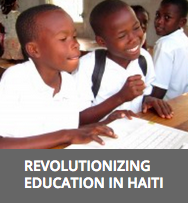Based on a submission by Michel DeGraff about his NSF-funded project to help Haitian faculty deepen their expertise in the innovative use of digital resources for STEM learning.

For the first time ever, Haitian faculty are using their national language of Haitian Creole (aka “Kreyòl”) for high school and university-level education in Science, Technology, Engineering and Mathematics (STEM). Open digital resources created at MIT and elsewhere, translated into Kreyol, are providing portable virtual laboratories to Haitian universities and high schools, most of which do not have access to traditional physical laboratories. Teachers are becoming passionate about active learning and facilitating it in their classrooms for the first time. The Initiative has garnered the support of key stakeholders, including educators at public and private universities throughout the country, alongside the highest echelons of the Haitian government.
NSF Project Information
Title: INSPIRE: Kreyol-based Cyberlearning for a New Perspective on the Teaching of STEM in local Languages
Award Details
PIs: Michel DeGraff, Vijay Kumar
The use of Kreyòl, coupled with state-of-the-art educational technology and online open-education resources, holds the promise of making quality education available to all in Haiti. This initiative has potential to help Haitian faculty and students leapfrog into universities of the future. The initiative presents a significant step in developing readiness and capacity to address the needs of the innovation-driven economy that Haiti needs, as STEM education has proven to be a major factor in economic development. The initiative also has potential to become a model for other countries in the Global South.
This project started as a response to the destruction of Haitian universities by the earthquake of January 12, 2010. One silver lining was the unique opportunity for Haitians to create a high-quality education system accessible to all. Currently only 10% of those who enter primary school graduate from high school. About 1% have some college-level study. In addition, most education is taught in French, and only 3 to 5% of the Haitian populations speaks French, whereas everyone speaks “Kreyòl.” The technology-enhanced STEM tools and Open Education Resources for active learning in Haitian Creole (“Kreyòl”) are building a solid basis for faculty and curriculum development in Haiti.
“(When I teach in Kreyòl) children ask more questions. Sometimes you even feel that they are speaking too much; then you switch over to French so that there will be less interactions in the class.”
We’ve been conducting a series of faculty- and curriculum-development workshops in Haiti, working with Haitian faculty to deepen their collective expertise in the innovative use of digital resources for active learning in STEM, specifically in physics, biology, biochemistry and math, with other STEM disciplines being considered for the future. The workshops are used to teach teachers to incorporate effective Kreyòl-based pedagogical techniques and resources into Haiti’s educational strategies and academic curricula and to get feedback from teachers that is used to refine curriculum units and the deveopment of scientific Kreyol vocabulary (called Language Engineering). The Initiative is looking at three factors at the core of modern STEM education: 1) online educational technology coupled with open education resources, 2) active-learning pedagogy, and 3) native language (i.e., Kreyòl) as medium of instruction. Each factor has been shown to independently enhance learning gains. Haitian faculty who participate in the INSPIRE workshops are disseminating these Kreyòl-based active-learning educational materials throughout Haiti.
Image credit: MIT EdTech Times Blog

